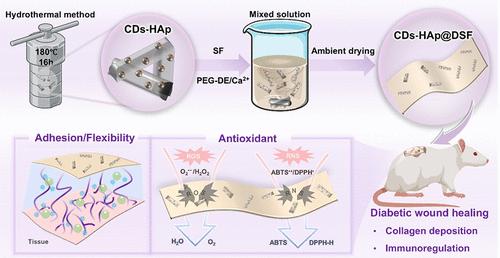拟酶羟基磷灰石用于糖尿病创面的免疫调节和胶原重塑功能
IF 8.2
2区 材料科学
Q1 MATERIALS SCIENCE, MULTIDISCIPLINARY
引用次数: 0
摘要
伤口敷料有望为愈合提供保护和再生环境。对于糖尿病慢性伤口,持续氧化应激和胶原重塑受损的特征提出了额外的挑战。羟基磷灰石(HAp)具有内在的生物相容性,是新发现的具有胶原刺激能力的基质重塑。另一方面,纳米酶样碳点(CDs)在抗炎和抗氧化应激应用中是可行的。受HAp和CDs共享高温合成条件的启发,我们开发了一种一步水热法制备铁掺杂CDs功能化HAp (CDs-HAp),以整合HAp的促胶原生物活性和Fe-CDs的多酶活性。通过将CDs-HAp嵌入双交联丝素(DSF)的仿生水凝胶膜中,我们创造了一种具有强大ROS清除和免疫调节功能的柔性和粘性伤口敷料(CDs-HAp@DSF)。我们证明CDs-HAp@DSF可以促进成纤维细胞增殖和胶原合成,同时减轻氧化损伤,促进巨噬细胞向抗炎M2表型极化。在体内,它通过协同促进胶原沉积、抑制病理性炎症和重塑再生免疫微环境来加速糖尿病伤口愈合。该设计利用基质重塑和酶促ROS消除同时靶向氧化应激、炎症和ECM失调,为慢性糖尿病伤口愈合提供了一种潜在的治疗策略。本文章由计算机程序翻译,如有差异,请以英文原文为准。

Enzyme-Mimetic Hydroxyapatite for Diabetic Wound Dressing with Immunomodulation and Collagen Remodeling Functions
Wound dressing is expected to provide protection and a regenerative environment for healing. For diabetic chronic wounds, the characteristic persistent oxidative stress and impaired collagen remodeling present additional challenges. Hydroxyapatite (HAp) with inherent biocompatibility is newly found to have a collagen-stimulating capacity for matrix remodeling. On the other hand, nanoenzyme-like carbon dots (CDs) are feasible for anti-inflammatory and antioxidative stress applications. Inspired by the shared high-temperature synthesis conditions of HAp and CDs, we developed a one-step hydrothermal method to fabricate iron-doped CDs-functionalized HAp (CDs-HAp) to integrate the collagen-stimulating bioactivity of HAp and the multienzyme activity of Fe-CDs. By embedding the CDs-HAp into a biomimetic hydrogel film of dual-cross-linked silk fibroin (DSF), we created a flexible and adhesive wound dressing (CDs-HAp@DSF) with robust ROS scavenging and immunomodulatory functions. We demonstrated that CDs-HAp@DSF can facilitate fibroblast proliferation and collagen synthesis while mitigating oxidative damage and promoting macrophage polarization toward the anti-inflammatory M2 phenotype. In vivo, it accelerates diabetic wound healing by synergistically enhancing collagen deposition, suppressing pathological inflammation, and reshaping the regenerative immune microenvironment. This design leverages matrix remodeling and enzymatic ROS elimination to concurrently target oxidative stress, inflammation, and ECM dysregulation, offering a potential therapeutic strategy for chronic diabetic wound healing.
求助全文
通过发布文献求助,成功后即可免费获取论文全文。
去求助
来源期刊

ACS Applied Materials & Interfaces
工程技术-材料科学:综合
CiteScore
16.00
自引率
6.30%
发文量
4978
审稿时长
1.8 months
期刊介绍:
ACS Applied Materials & Interfaces is a leading interdisciplinary journal that brings together chemists, engineers, physicists, and biologists to explore the development and utilization of newly-discovered materials and interfacial processes for specific applications. Our journal has experienced remarkable growth since its establishment in 2009, both in terms of the number of articles published and the impact of the research showcased. We are proud to foster a truly global community, with the majority of published articles originating from outside the United States, reflecting the rapid growth of applied research worldwide.
 求助内容:
求助内容: 应助结果提醒方式:
应助结果提醒方式:


